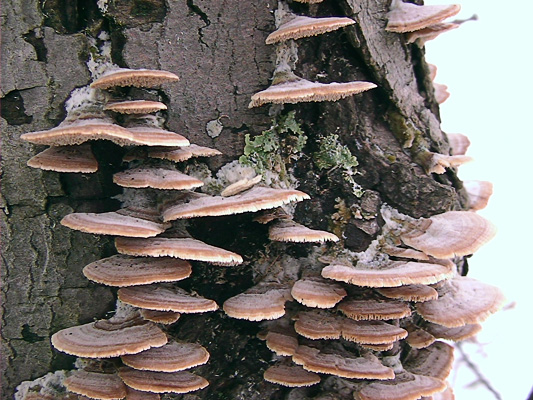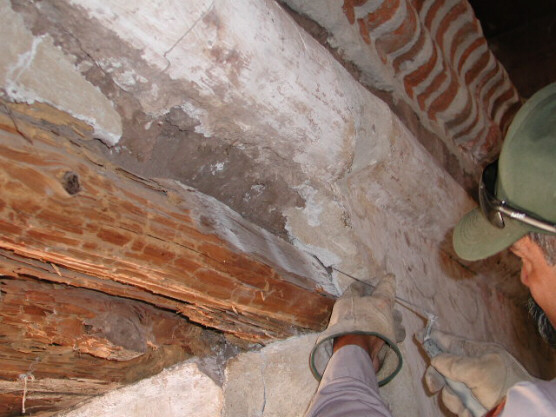I hope you're doing well and enjoying spring. I also hope you'll find the following article
about decay fungi by Dr. Michelle Seidl, both interesting and useful.
With best wishes,
Dave Gallup
Decay Fungi Overview
By Dr. Michelle Seidl, EMLab P&K Mycologist
Every year an enormous amount of wood and wood products are destroyed by decay, rot
and decomposition. Decomposition refers to the process by which tissues of dead
organisms break down into simpler forms of matter. Such a breakdown is essential for
new growth and development, because it is the basis for recycling limited chemical
compounds, as well as freeing up limited physical space in the environment. Fungi
are the main organisms responsible for wood decay. A wide range of fungi occur on wood
using various constituents for their metabolism. This article is a general overview
of the fungi, primarily basidiomycetes, involved in wood decay as it relates to
structural integrity of building materials, buildings, milled wood and wood products.
Decay fungi need oxygen, water and a food source to exist. Wood as a food source is
limited to those fungi which are able to utilize the components and in the process
break down the wood. Since wood and wood products are used in construction of commercial
and residential buildings, the key to longer lasting wood structures and products is to
keep the wood dry. Dry wood will not decay. If you add water to dry wood, the cell walls
absorb water up to a moisture content of about 28%. Above that, the wood reaches the fiber
saturation point and free water becomes available. Decay fungi require free water so the
moisture content of wood must be above 28% to decay. For practical purposes, a value of 20%
is used as a cutoff, leaving a margin of error for avoidance of decay. Fungi have an
external method for breaking down their food by secreting digestive enzymes and other
chemicals into the substrate where they are growing. This enables the fungi to then absorb
predigested food products. This external digestion process requires that liquid water be
present so the enzymes can be secreted and then the useable food products can diffuse back
into the fungus. Without this moisture, the fungus cannot be active or grow. Without water,
it may either become dormant or die.
Wood decay is generally classified into two main groups, white rots and brown rots,
based on the wood residue left behind following fungal digestion. Two other types include
"dry rot", which is a form of brown rot caused by water-conducting decay fungi,
and "soft rot", referring to decay caused by certain ascomycetes and asexual
fungi (not covered here).
The main wood-inhabiting group of basidiomycetes are commonly known as the polypores. It's
estimated that in North America, no less than 100 species of polypores cause decay in woody
plants and timber, while approximately 75 species are responsible for 90% of the important
decays produced in timber and wood products. Most polypores are saprophytic and utilize dead
wood as their food source. These fungi commonly appear as hard, tough, corky, leathery or
woody structures of various shapes and sizes (see figure 1). They have a fertile surface
(where spores are produced), usually made of pores or tubes closely packed together.
Polypores are mostly wood inhabiting fungi that are able to utilize components of wood as
their primary source of energy for growth and reproduction. When a fruiting body is seen on
wood, the mycelium, or main body of the fungus, is usually not so visible, growing within
the wood obtaining nutrients from it.

Figure 1: Orange-brown polypore fungus (family Polyporaceae), with some leafy
("foliose") green lichen, on the trunk of a dead tree. Winter, Mine Falls Park, Nashua, New Hampshire.
Source: HikingWithChuck.com, used with permission
Copyright © 2008 by Charles J. Bonner, all rights reserved
When fungi decay wood, the process involves breaking down complex chemical compounds,
primarily cellulose and/or lignin. Cellulose is a polysaccharide composed of linear chains
of glucose molecules. All plants have this chemical compound as the primary cell wall
component. Cellulose is the most common organic compound on Earth and makes up roughly 50%
of wood. Lignin is a complex polymer of phenolic units and relatively resistant to decay.
It plays a key role in the carbon cycle as the most abundant aromatic compound in nature,
providing a protective matrix in the plant cell wall. This amorphous and insoluble polymer
is not susceptible to hydrolytic attack, in contrast to cellulose. Although lignin is a
formidable substrate, its degradation by certain fungi was recognized and described nearly
125 years ago. These basidiomycetes are the only organisms capable of efficient
depolymerization and mineralization of lignin.
White rot fungi primarily break down these lignin components in wood, and secondarily the
cellulose. These fungi have extracellular enzymes such as cellulases and lignases to break
down the complex molecules. Scientists have been studying these enzyme systems for industrial
purposes and potential uses, including bioremediation. The wood decayed by white rot fungi
results in a lighter colored wood, appearing bleached and paler than nondecayed wood. The
consistency changes from hard to soft and fibrous, spongy, stringy or laminated. White rot
fungi eventually decay the wood completely, and in nature, any residues left behind following
the decomposition process are not useful in soil building. The strength factor of a structure
being decayed by a white rot fungus is more slowly altered and frequently the rotting wood is
still usable in the early stages of decay. White rot is more common in hardwoods (i.e. angiosperm
wood such as oak (Quercus sp.)).

Figure 2:
Preparing to remove old wood (white rot) from the Tumacácori Mission church at
Tumacácori National Historical Park, Arizona.
Source: National Park Service, Photo by Jana Tschopp
With brown rot fungi, cellulose is removed but the lignin remains behind. In advanced stages,
the wood appears brown to dark brown in color and is often cracked cubically. The fibrous
texture is lost early on in the decay process, due to the removal of cellulose. Brown rot is
more common in conifer wood (i.e. gymnosperm wood such as pine (Pinus sp.) and fir
(Abies sp.)). The brown rot residues left behind after the decay processes are
important organic components of forest soils. These brown rot fungi are extremely important
in recycling carbon in the ecosystem. Species of brown rot fungi are relatively few when
compared to species of white rot fungi. Geographically, brown rot fungi become less
numerous in the tropics when compared to temperate regions of the northern hemisphere.
Dry rot is a very efficient decay fungus with quite specific environmental requirements and is
viewed by some as a subcategory of brown rot fungi. It has been referred to as a "house-destroying
super organism." Much of the perplexities concerning dry rot stems from the rather confusing
use of common names for describing building fungi. Dry rot in North America is Meruliporia
incrassata, but also known by an older name, Poria incrassata, the water-conducting
fungus. This is also known as 'poria fungus', undoubtedly due to the fact that in the early
1900's it was a member of the genus Poria. In the United States, this fungus seems to be
more common in the southern states, but can be found worldwide. Though it may sound incorrect,
dry rot fungi are known as water conducting. Actually this fungus differs from most other wood
decay fungi in several respects. They can produce large, semi-tough, water-conducting, root-like
structures called rhizomorphs. The structures transport water by capillary action from a constant
source (usually damp or wet soil) to dry wood in a building. This dry wood becomes wet from the
fungus when the rhizomorphs come in contact with the wood and decay is inevitably supported. As
the decay proceeds, water is conducted to additional areas of dry wood adjacent to that which is
already colonized. In this manner, as long as the supply of water is available, water-conducting
fungi can colonize and decay the wood of the entire structure. In the UK, dry rot is a common
name applied to Serpula lacrymans. This species was formerly known as Merulius.
These fungi can digest both the lignin and the cellulose of wood. A small amount of this type
of decay markedly alters the strength of wood.
No information is available for health effects, toxicity, or allergenicity with regards
to these fungi. The actual damage that decay fungi cause in timber is enormous yet difficult,
if not impossible, to accurately determine. Each year a large amount of timber is lost on
account of decay fungi in forests as well as in and on wood products and structural timbers.
References:
University of California Cooperative Extension: Meruliporia 'poria' incrassata (PDF, 1.5MB)
"Cellulose." Encyclopaedia Britannica. 2008. Encyclopaedia Britannica Online. 11 Jan. 2008
University of California Cooperative Extension: Moisture and fungi in homes: California issues (PDF, 2.3MB)
Gilbertson, R. L. and L. Ryvarden. 1986. North American Polypores. Vol I. Fungi flora: Oslo
Overholts, L. O. 1967. The polyporaceae of the United States, Alaska, and Canada. The University
of Michigan Press: Ann Arbor